Aaron Hendry completes his PhD
Back in early October 2017 Aaron submited his PhD thesis for examination. Today that process came to an end – examiners reports arrived, some small revisions were required, and the changes were accepted. On 8 January 2018 Aaron took the final hardbound thesis over to Registry to hand them over. The examination processes has ended, and we have had confirmation that his thesis had been accepted. His thesis was entitled “Experimental evidence and properties of EMIC wave driven electron precipitation”. Aaron cannot use the”Dr” title until he has graduated, but he clearly has won this recognition, except for that formality. Congratulations Aaron! [8 January 2018].
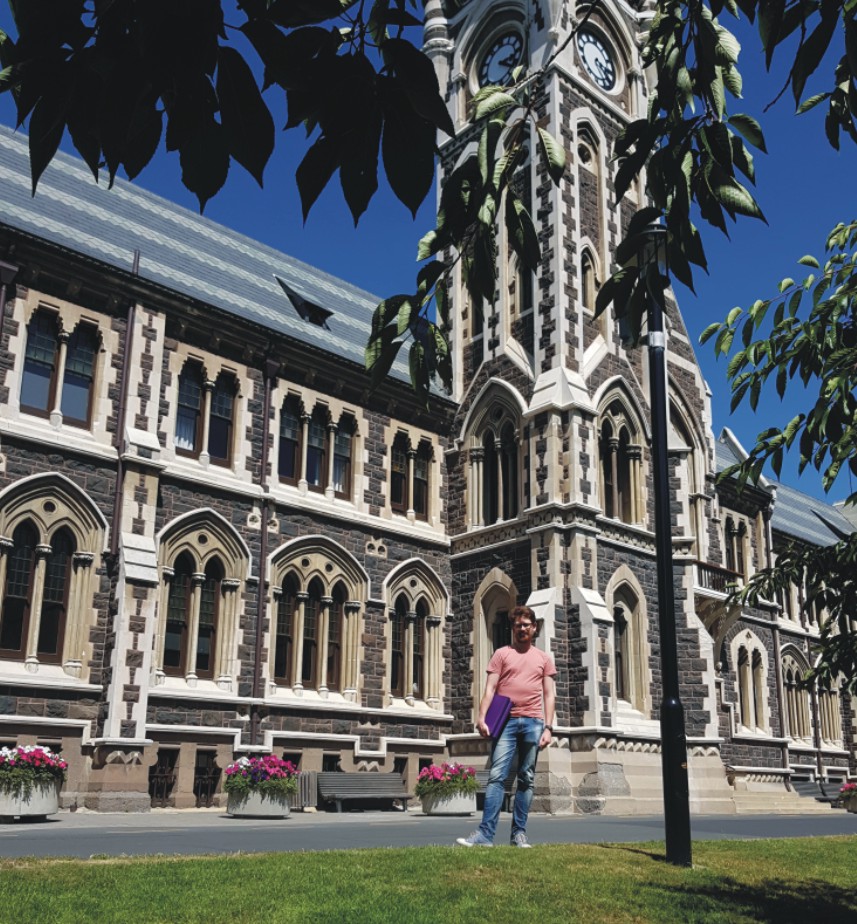
Aaron in front of the University of Otago clocktower, about to enter to hand in the thesis documents he is holding.
Press Release on our research
Today the University of Otago and Victoria University of Wellington put out a press release on the impact of geomagnetic storms on New Zealand’s technological infrastructure. In particular, the large geomagnetic activity from 7-9 September may have triggered the failure of the fuel pipeline supplying Auckland airport a few days later. You can see the original press release from Otago here, and from Victoria here. A nice story in the New Zealand Herald was published shortly afterwards [24 October 2017].
Aaron submits thesis
This is a very special day for the Space Physics group at Otago. Today PhD candidate and Space Physics student Aaron Hendry walked over to the Graduate Research School in the University clocktower building and submitted his PhD thesis. During Aaron’s time as a PhD student he produced two first author papers, and co-authored multiple other studies. His work on EMIC wave driven scattering of radiation belt scattering has led to significant new understanding in the field. His thesis was entitled (“Experimental evidence and properties of EMIC wave driven electron precipitation”). Well done Aaron! [6 October 2017].
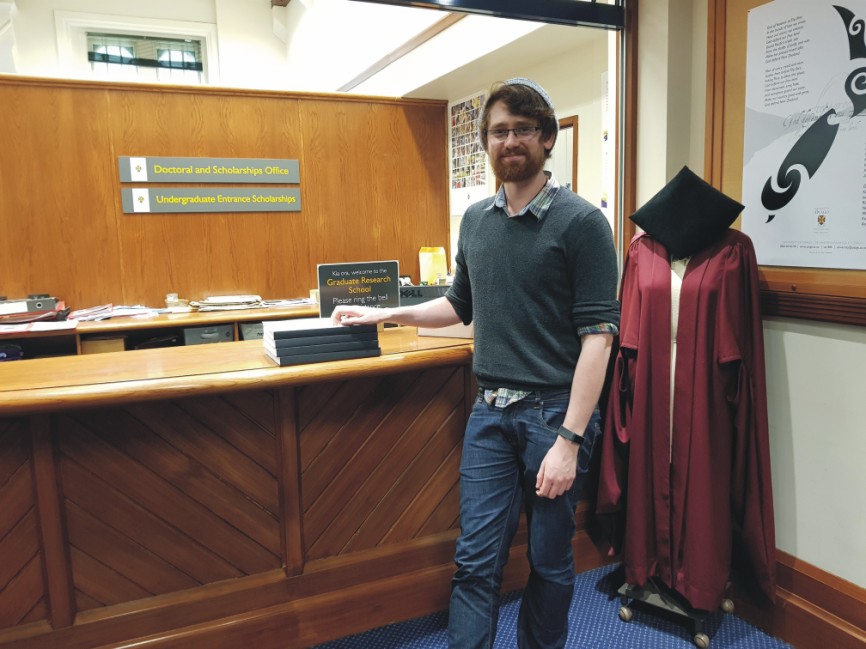
Aaron at the front desk of the Graduate Research School, handing the thesis over for examination!
Our research featured on journal cover
Recently we were very pleased to have a paper accepted in the American Geophysical Union journal Space Weather. The paper came from our MBIE funded project on the hazard posed by Space Weather events to New Zealand’s electrical transmission network. In it we were describing the amazing dataset of DC measurements which have been made and achieved by Transpower New Zealand covering many of the transformers in the South Island – this dataset is well in advance of what many countries posses. Today we learnt that one of the figures from our paper was featured on the cover of the August edition of the journal. The research described in the paper was primarily undertaken by Daniel Mac Manus, then a Space Physics Honours student, working under the supervision of Prof. Craig Rodger. The paper itself can be found online on the space physics website or from the journal itself. The citation is Mac Manus et al. (Space Weather, 15, 1020–1038, doi:10.1029/2017SW001635, 2017) [29 September 2017].
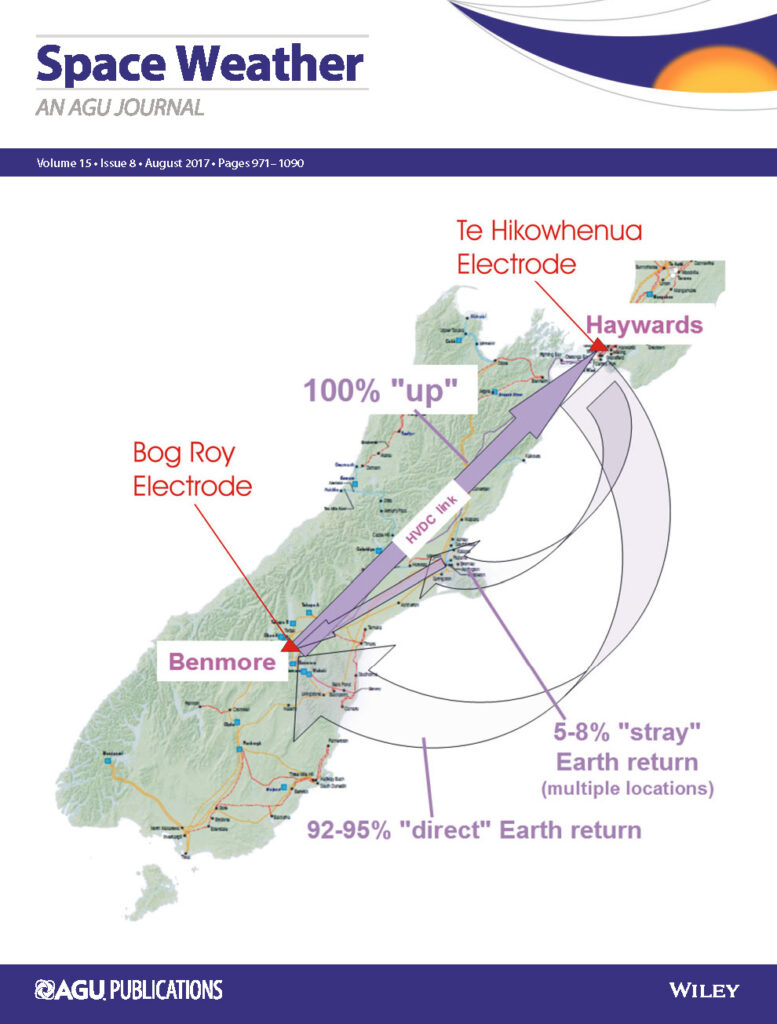
Cover image of the American Geophysical Union journal Space Weather (Volume 15, Issue 8, August 2017, Pages 971– 1090).
Multiple Awards for Emma
For the last 3 weeks the Space Physics group has been travelling. Emma Douma and Craig Rodger went to Montreal to attend the 32nd General Assembly of the International Union of Radio Science (URSI, 19 – 26 August 2017). From Montreal they travelled to Cape Town to be part of the IAPSO-IAMAS-IAGA Joint Assembly (IAGA, 27 August – 1 September 2017), and Tim Divett joined them there coming straight from Dunedin.
At the URSI meeting Emma was presented with her URSI Young Scientist Award. This programme supported a number of young scientists to attend the URSI General Assembly and Scientific Symposium. During the IAPSO-IAMAS-IAGA Joint Ceremony there was a special ceremony to present awards from IAGA to five people. Emma Douma was one of three to receive an IAGA Young Scientist Award for her outstanding student presentation at an IAGA sponsored meeting (in this case the 7th VERSIM workshop in 2016). At both of these major scientific meetings Emma gave invited presentations. Congratulations to Emma [8 September 2017]!
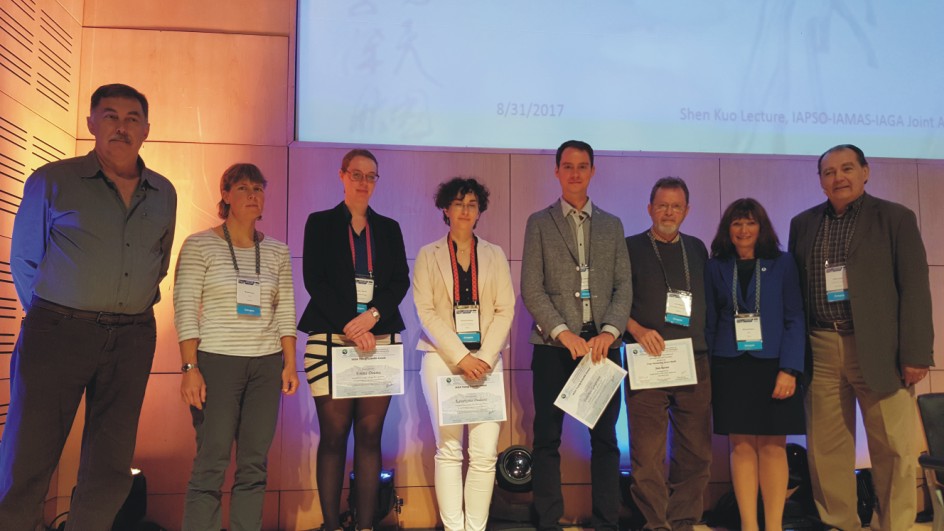
IAGA Awards Ceremony, Cape Town, South Africa, on 31 August 2017.
Welcome to Annika, our new colleague
Back at the start of 1 June 2017, a new colleague joined the Department of Physics and also Otago’s Space Physics Research group. At that point Dr. Annika Seppälä formally started as a new faculty member in our Department. While she is a new academic she is actually well known to our group, having been a collaborator for more than 12 years now! The group is very happy she has left Europe and brought her husband and young son to New Zealand. Belated welcome to Annika, and we hope she will be very happy and productive with us in Dunedin [11 August 2017].
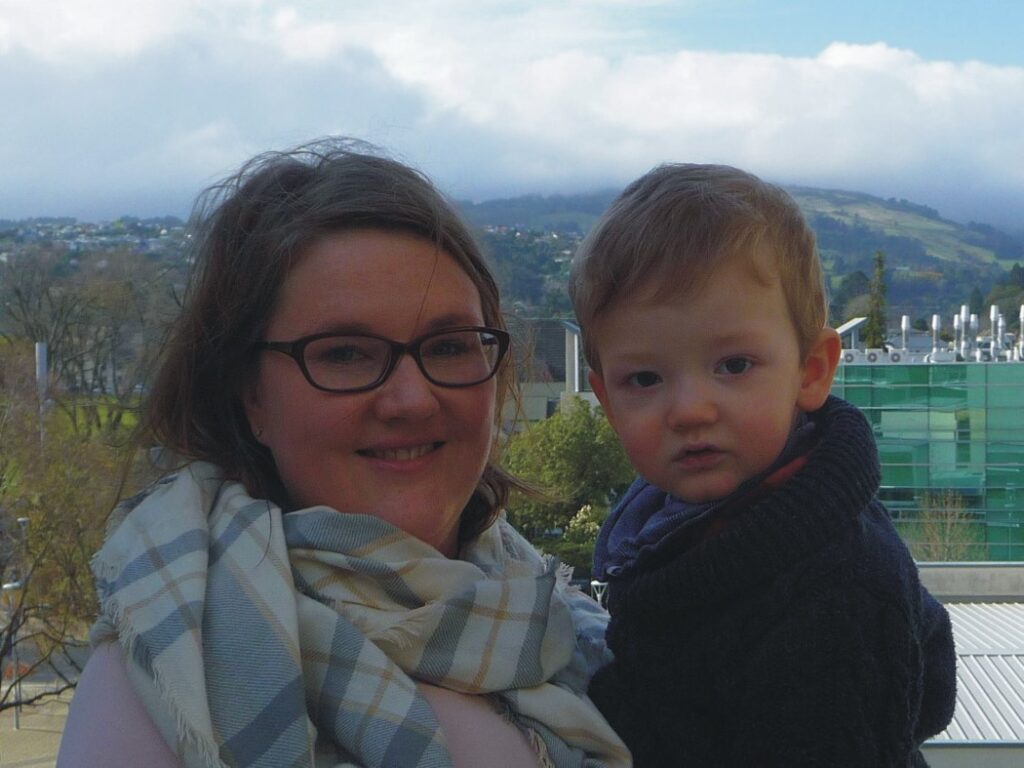
In Awe of the Aurora
On Tuesday night Otago Museum hosted a set of fully booked public talks entitled Solar Tsunamis: In Awe of the Aurora. Over two hundred people attended, with advice on viewing and photographing the aurora from Dunedin. The Otago University Space Physics research group took this opportunity to inform the public of our new Aurora Alert system, which uses magnetometer measurements to produce a nowcast of aurora activity. The Aurora Alert system was developed with funding support from our MBIE project. The system is designed to alert people in the lower South Island [1 August 2017].
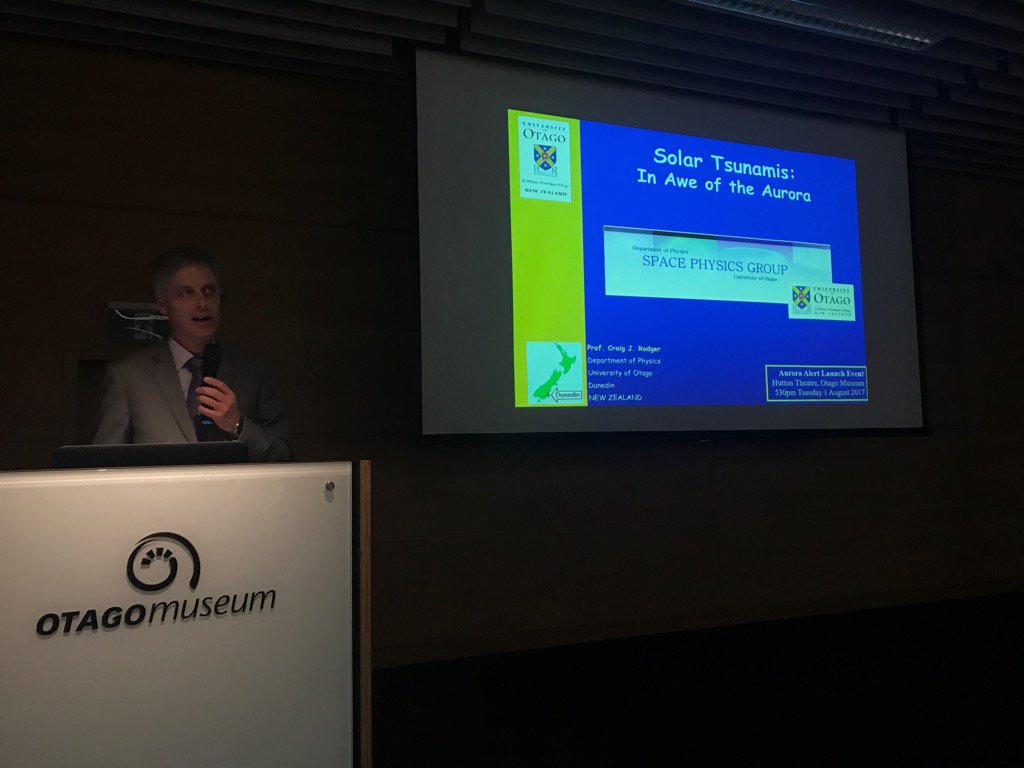
Professor Richard Blaikie, Deputy Vice-Chancellor (Research), opens the Solar Tsunami talks
Craig talks at the Sunroom
Last week Craig Rodger gave a talk at an artist presentation which ran in central Dunedin city every evening for 2 weeks. The presentation was entitled Sunroom: a space to stare at the Sun. It was the brainchild of visiting Otago Polytechnic design lecturer Trudy Lane and local amateur astronomer Mirko Harnisch. For more information on the Sunroom event see the Otago Daily Times article from 16 June 2017 Great Ball of Fire and The Star article “Space to stare at the sun” [20 June 2017].
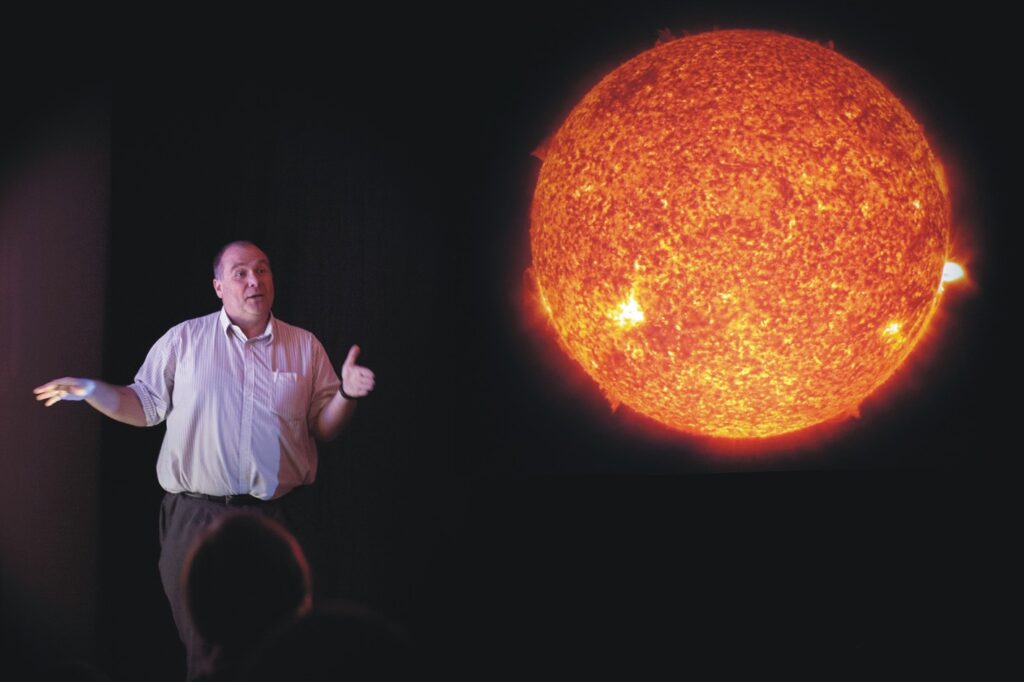
Moritz Wolf Photographs the Aurora
For the last few months the Otago Space Physics has been hosting research intern Moritz Wolf, an Engineering Physics student from the Munich University of Applied Sciences. Moritz has been working on an aurora warning system for the Dunedin area, using magnetic field measurements made locally and regionally. Moritz will be leaving us in ~2 weeks, but has now made a system we are testing. Last Friday the system suggested a “level 2” warning on a 9-point scale – which we think corresponds to aurora occurring low in the sky and faint (likely not naked-eye visible), but with a short period of “level 4”. Moritz headed off to Sandfly Bay and shot the following stunning movie! Moritz could not see the aurora with his unaided eyes, but others in the Dunedin region could, particularly when it got brightest [25 February 2017].
[Note that this aurora was not naked eye visible, but Moritz has a fancy camera!]
Craig Rodger give “Director’s Choice” talk at the British Antarctic Survey
Today Craig Rodger gave a Director’s Choice presentation at the British Antarcric Survey (BAS). In doing so he marked a number of firsts. Not only was he the first non-BAS staff member to give a presentation, he was the first speaker to use the brand new conference room in the “Aurora Cambridge Collaboration Space“, which has been built to encourage innovation between BAS and wider industry. Craig spoke on Space Weather, which seems very appropriate given the name of the new rooms. His presentation was entitled And then the Sun went “Bang”: An overview of Space Weather research [17 February 2017].
Expedition 9 home safe
Last Saturday Dr James Brundell and Space Physics PhD student Emma Douma returned to Dunedin from Scott Basem ending the Otago Space Physics Group’s ninth annual Antarctic expedition. James and Emma travelled on schedule, and met all the goals of the event. Welcome back! [12 February 2017].
Expedition 9 on the plane, heading to Antarctic
This morning Dr James Brundell sent us a photo taken inside the USAF C-17 transport which would take himself and Space Physics PhD student Emma Douma down to Scott Base. James and Emma were scheduled to take off at 10am, and so should be on the ice mid-afternoon today. This Otago Space Physics Group’s ninth annual Antarctic expedition, James’ eighth visit to Scott Base, and Emma’s second. The logistics support, comprising air transport, accommodation, and all other on-ice support is provided through Antarctica New Zealand Event K060. Expedition 9 will gather high resolution data, undertake calibrations and check the condition of both the Arrival Heights magnetic field loops and the new WWLLN electric field antenna near Scott Base. The new antenna was installed by Expedition 8 in November 2015, and we want to see how it has survived more than a year of continuous exposure. The team will also undertake noise measurements at and around Arrival Heights [1 February 2017].
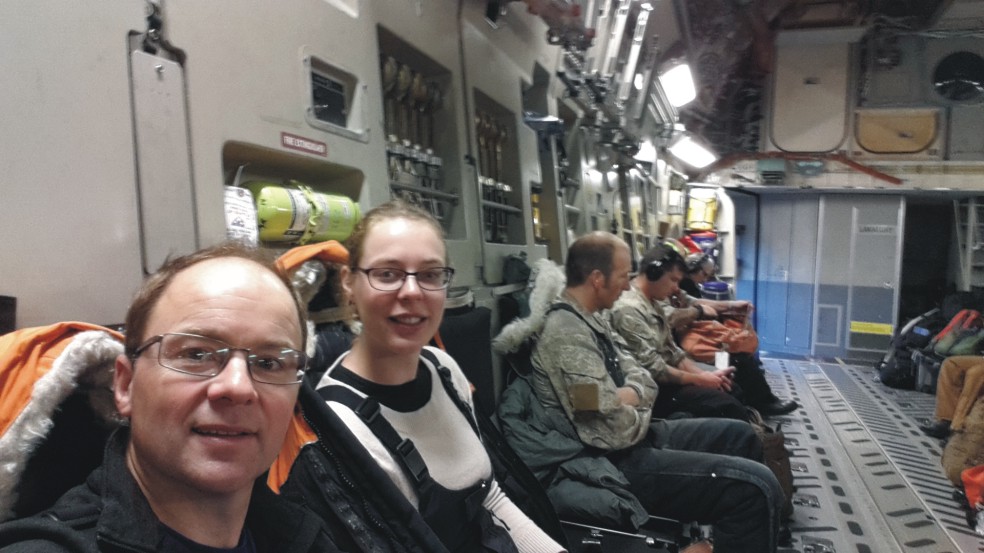
Not long till take off!
Expedition 9 preparing for travel to Antarctica
The Otago Space Physics Group’s ninth annual Antarctic expedition is now preparing to head South. Dr James Brundell is again the on-ice event leader, which will be James’ eighth visit to Scott Base in the last nine years! Space Physics PhD student Emma Douma will be travelling with James for her second visit to the Ice. The team is currently scheduled to travel to Scott Base on Monday 1 February 2017 for another 9-day highly intensive working period (planned return is Friday 10 February). The logistics support, comprising air transport, accommodation, and all other on-ice support is provided through Antarctica New Zealand Event K060. This is the first time that the Otago Space Physics Group has sent an expedition down so late in the season, and we are really interested to see how different the conditions will be.
Expedition 9 will gather high resolution data, undertake calibrations and check the condition of both the Arrival Heights magnetic field loops and the new WWLLN electric field antenna near Scott Base. The new antenna was installed by Expedition 8 in November 2015, and we want to see how it has survived more than a year of continuous exposure. The team will also undertake noise measurements at and around Arrival Heights [19 January 2017].
Moritz Wolf joins us a Research Intern
Moritz Wolf has recently joined the Otago Space Physics group as a research intern. Moritz is a student from the University for Applied Science in Munich, Germany. He is studying for a Bachelor Physikalische Technik (Engineering Physics), and will be working with us from mid-October through to March 2017. Before getting to Dunedin Moritz started exploring New Zealand on holiday, and we expect he will keep travelling in the weekends and holidays during his visit. Moritz is working with us on a magnetometer based aurora warning system for the lower South Island [October 2016].
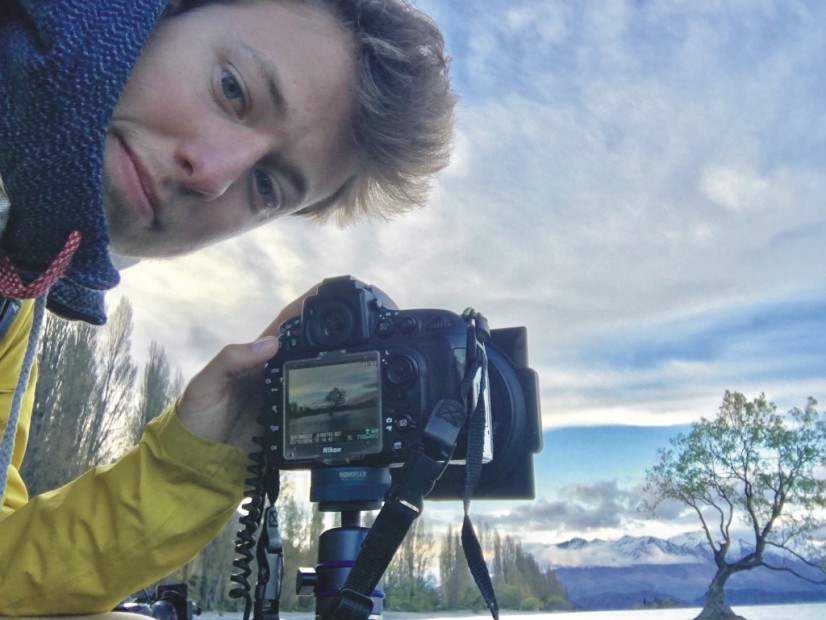
Emma Douma nominated for IAGA Young Scientist Award
In September PhD student Emma Douma travelled overseas to attend two different conferences. The second one of these was the 7th VERSIM Workshop in Hermanus, South Africa, hosted by the South African National Space Agency. The workshop scientific committee declared Emma had given the best presentation by a Young Scientist. She will be therefore be nominated for the IAGA Young Scientist Award. Congratulations Emma! [24 September 2016]
Craig Rodger to give a public talk in South Africa!
At the end of next month Prof. Craig Rodger will be giving a public talk for the South African National Space Agency (SANSA). The talk is to be given at SANSA Space Science, which is located in Hermanus in the Western Cape. Craig is travelling to Hermanus to attend the 7th VERSIM workshop, which will be hosted there from 19-24 September 2016. SANSA has produced an eye-catching poster to advertise the event. Craig’s talk was recorded, and placed on SANSA’s You Tube channel.
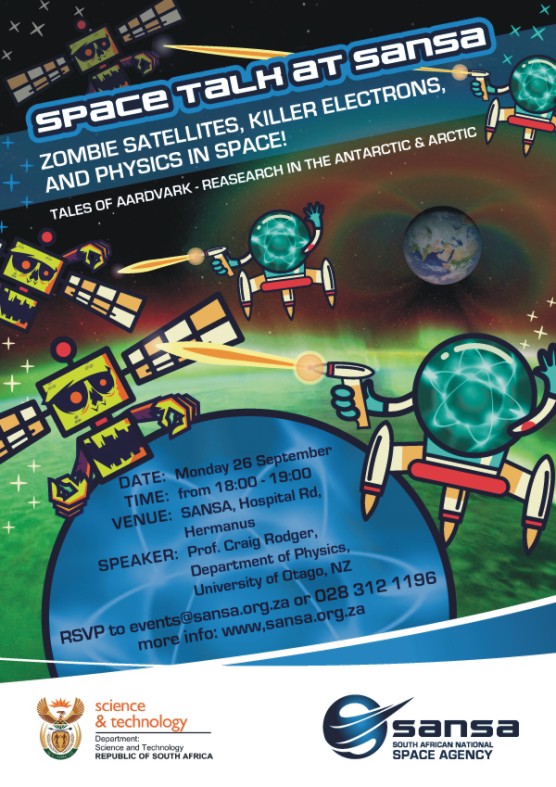
Kickoff meeting for our Geomagnetically Induced Currents (GIC) research project
For the last fortnight we have been hosting 3 visitors from the United Kingdom. These were Alan Thomson and Ellen Carke (British Geological Survey) from the BGS Geomagnetism team based in Edinburgh and Mark Clilverd (British Antarctic Survey). Their visit was to move forward on our MBIE-funded Geomagnetically Induced Current research project. Alan and Ellen worked with Tim and Craig on the New Zealand GIC measurements, geomagnetic storms, and modelling approaches. Mark worked with James and Craig on the new monitoring equipment and also understanding the GIC measurements. During their visit we hosted the kick-off meeting for our GIC research project, bringing together the New Zealand and UK team members. Alan and Craig also had a really interesting meeting with the Director of Otago Museum, Ian Griffin, about aurora warning.
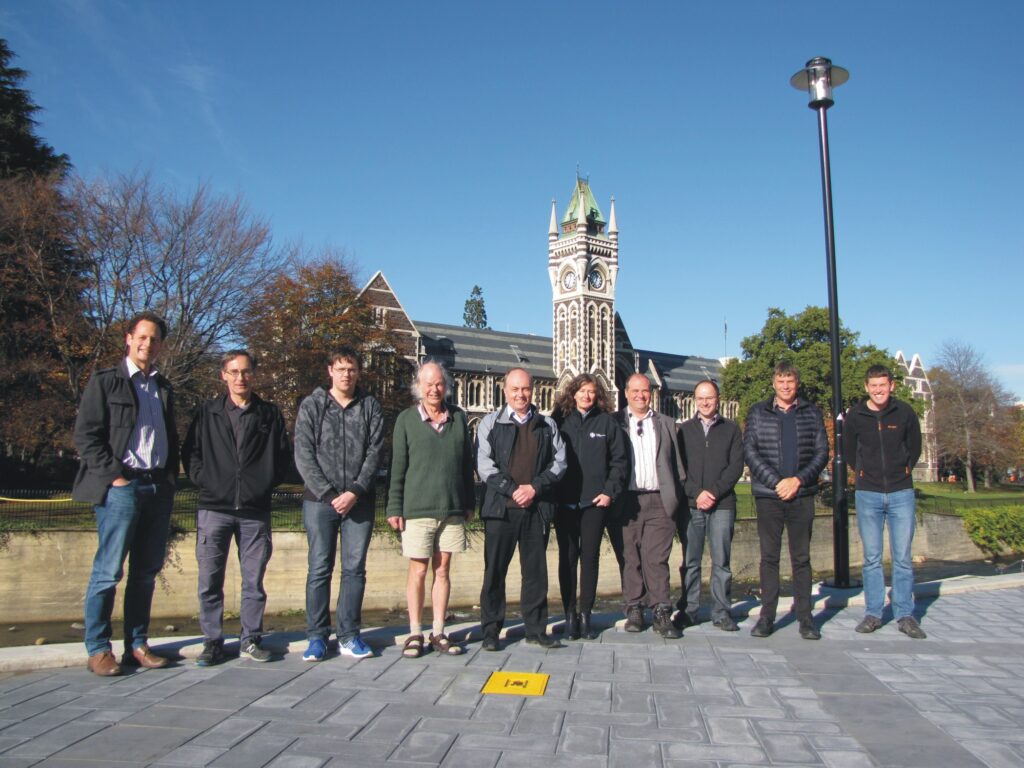
The participants were (left to right): Tim Divett (Otago), Malcolm Ingham (VUW), Daniel Mac Manus (Otago), Neil Thomson (Otago), Alan Thomson (British Geological Survey), Ellen Clarke (British Geological Survey), Craig Rodger (Otago), James Brundell (Otago), Mark Clilverd (British Antarctic Survey), and Mike Dalzell (Transpower). The kick off meeting was on Wednesday 25 May 2016.
The day after our kickoff meeting the science show on Radio New Zealand, Our Changing World, broadcast an interview with Craig Rodger about our research work (first broadcast on 26 May). [31 May 2016].
Assoc. Prof. Neil R. Thomson retires
Early this month was the last formal working day of Neil Thomson as a full time member of our Department’s academic staff. After 38 years of continuous work for the Otago Physics Department Neil took formal retirement on 8 April 2016. In fact, his working life in Physics actually stretches back to when he was first employed by the University as a student demonstrator 52 years ago! Over that time he has been a successful and reliable lecturer, filled many administrative roles across our Department, and produced research that has received worldwide media coverage – and he has also been a highly skilled supervisor of postgraduate students, guiding them to completion.
While Neil is retiring, he is not “gone”. He is continuing to work on research projects, and is employed part time on our MBIE research project through to late 2018! We are having a Departmental dinner to mark Neil’s service near the end of this month [20 April 2016].
Emma Awarded 2016 Edward and Isabel Kidson Scholarship
Space physics PhD student Emma Douma has been awarded the Edward and Isabel Kidson Scholarship for 2016 (but the funding lasts 3 years). She intends to use the funding support her travelling to international conferences. In 2016 she plans to attend the ISROSES – III (12 – 16 September) meeting in Varna, Bulgaria and hopefully aslo make it to the 7th VERSIM workshop (19 – 23 September) in Hermanus, South Africa [27 January 2016].
Professor Craig Rodger is now HoD
At the start of 2016 Space Physics research group leader Craig Rodger became Head of Department of the Otago Physics Department. He takes over from Assoc Prof. Pat Langhorne. This is a 3-year appointment [1 January 2016].
Craig Rodger back from the world
For much of December Craig was back on the road and in the northern hemisphere. In the UK he visited colleagues at the University of Lancaster and then headed north to spend several days talking about Geomagnetically Induced Currents with the geomagnetism team of the British Geological Survey in Edinburgh. Then Craig headed to Finland to attend the 2015 CHAMOS workshop hosted by the Sodankylä Geophysical Observatory (and saw the aurora!). Finally, he travelled to San Francisco to give an invited talk at the American Geophysical Union Fall Meeting [22 December 2015].
Expedition 8 home and safe
In the early evening of Tuesday 24 November Space Physics PhD student Emma Douma and Dr James Brundell arrived back in Christchurch on a RNZAF C-130 Hercules, returning safely and on schedule from their time at Scott Base. You can read more about thier workplan at this webpage.Their entire trip went as planned, with flights south and north on the days planned – this is especially impressive as there were major travel disruptions during the week they were working on the ice. The following morning Emma and James flew back to Dunedin. Well home Expedition 8! [17 November 2015].
Expedition 8 now working “on the ice”
Last Monday at about 715am Dr James Brundell emailed us a picture from inside the USAF C-17 Globemaster III, shortly before it took off for Antarctica (that is Monday 16 November). James and Space Physics PhD student Emma Douma left on time, and landed at Pegasus Field just a bit after 1pm. By 1:30pm they were on ‘Ivan’ heading towards Scott Base. Emma and James are now working hard as the two members of Otago Space Physics’ Expedition Eight. You can read more about thier workplan at this webpage [17 November 2015].
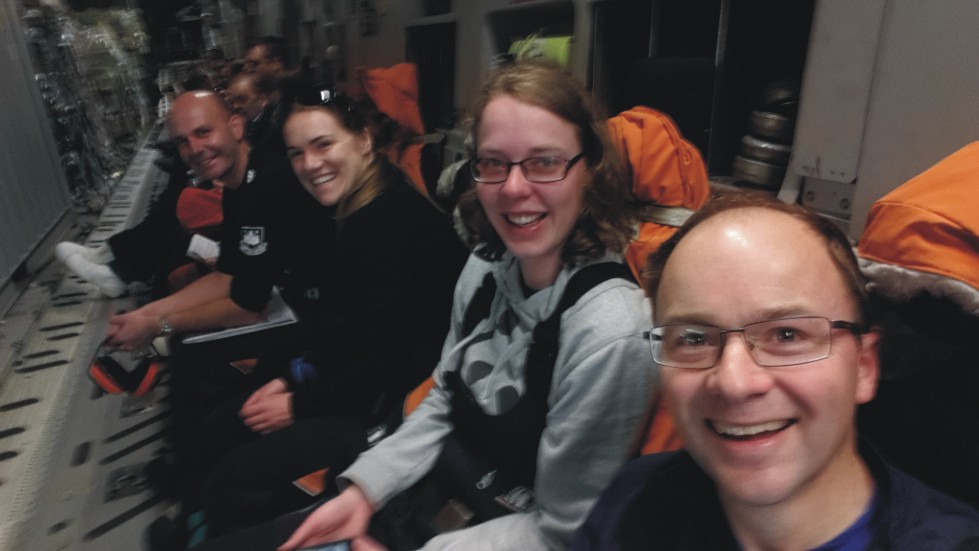
About to fly South!
Craig Rodger visits Matariki Network of Universities partner Dartmouth College
At the end of his Fulbright New Zealand Fellowship in the USA, Prof. Craig Rodger went from Boulder to Hanover (New Hampshire) to visit Dartmouth College. Dartmouth is one of the oldest universities in the US. Both Otago and Dartmouth are part of the Matariki Network of Universities, and Craig had won an Otago MNU Travel Award to visit Dartmouth. He primarily talked to the space physics researchers there who investigate energetic electron precipitation using balloon-borne X-ray detectors. Craig gave a seminar, and also a Departmental Colloquium. The later presentation was videoed, and has been placed online [13 November 2015].
Expedition 8 preparing for travel to Antarctica
The eighth Antarctic expedition from the Otago Space Physics group is getting ready for their trip down to the Ice. As in previous years, Dr James Brundell is the on-ice event leader (these are the names used by Antarctica New Zealand for the roles we fill), and he will be supported by Space Physics PhD student Emma Douma. The main goal of Expedition 8 is to install a new WWLLN electric field antenna near Scott Base. Previously we have used the AARDDVARK magnetic field antenna located at Arrival Heights to provide data to both AARDDVARK and WWLLN. However, the local magnetic field noise in the VLF frequency range at Arrival Heights has got steadily worse, possibly linked to the Ross Island Wind Farm. During Expedition 6 and Expedition 7 we confirmed that the electric field noise is substantially lower near Scott Base than at Arrival Heights, and thus we should get better measurements from close to base.
The team is currently scheduled to travel to Scott Base on Monday 16 November 2015 for another 8-day highly intensive working period (planned to return on Tuesday 24 November). The logistics support, comprising air transport, accommodation, and all other on-ice support is provided through Antarctica New Zealand Event K060.
This is James’ 7th visit to Antarctica and Emma’s first. Expedition Eight will also gather high resolution data, undertake calibrations and check the condition of the Arrival Heights AARDDVARK radio receiver we originally installed in December 2008. You can read more at this webpage [13 October 2015].
Craig Rodger visits Houston and then gives a Public Talk in Boulder
Last week Prof. Craig Rodger was a busy soul. Early in the week he left Boulder and travelled south to Houston to give a Space Physics seminar at Rice University. After returning, he gave the inaugural Public Lecture for 2015 at the Laboratory for Atmospheric and Space Physics, Colorado University at Boulder. The public lecture was videoed and is available online from YouTube [12 October 2015].
Space Physics PostDoc Position Available
The Otago Space Physics group is currently advertising for a Postdoctoral Fellowship position. This is funded through our recently awarded MBIE project. It is a 2.5-year fixed term position. The project is to investigate the hazard posed by geomagnetically induced currents to the New Zealand electrical transmission network during extreme geomagnetic storms. The successful candidate will build a model to describe geomagnetically induced currents in the New Zealand network. More than 10 years of experimental geomagnetically induced current measurements are available to validate the mproodel, after which the candidate will apply it to investigate the risk posed by extreme geomagnetic storms. The position is available for application from this point, and will remain open until it is filled (the candidate must start at Otago in April 2016).
Applicants should have a PhD in Physics and a demonstrated strength in one of the areas of Space Physics, Ionospheric Physics, Geomagnetism, Space Weather and/or Geophysics. For further information, please see the Job Description or the online advertisement [28 September 2015].
Space Physics Group wins MBIE funding to do Space Weather Research
The Space Physics research group has been awarded $1,467,000 of funding from a MBIE (Ministry of Business, Innovation & Employment) Targeted Research: Hazards and Infrastructure Research Fund grant in the latest science investment funding round. This grant will support the research of Otago Staff Prof. Craig Rodger, Assoc. Prof. Neil Thomson and Dr. James Brundell, plus Dr. Malcolm Ingham of Victoria University of Wellington for 3-years starting October 2015. We will also be collaborating with Space Weather experts from the British Geological Survey and the British Antarctic Survey, and the power engineers of Transpower New Zealand. Our research will focus on the risk posed by extreme geomagnetic storms to the New Zealand electrical transmission network.
A more detailed description of our project can be found on the Otago news website [3 September 2015].
Space Physics research inspires Art Exhibition
This week marks the opening of the Art and Light exhibition at Otago Museum. The idea of he display was to mark 2015 as the Year of Light. Dr. James Brundell and Craig Rodger worked with artists David Green and Sarah McKay to inspire three different art installations. One made use of our real-time wideband VLF feed to detect the sferics generated by lightning and project images of lightning on the viewers body. Another used whistler mode chorus recordnigs made by Craig’s colleagues at the University of Iowa from their EMFISIS experiment on the Van Allen Probes. Finally, the work by Sarah McKay was inspired by the idea that the radio waves we use are a type of light, but in a range we cannot see with our eyes. A story including descriptions of our work was published in the Otago Daily Times on 17 August 2015 (“Seeing the light”). The exhibition is open from 15-30 August [19 August 2015].
Craig Rodger visits Minneapolis
Last week Prof. Craig Rodger flew out of Iowa City to undertake a collaborative visit to the Space Physics researchers at Augsburg College, Minneapolis. While in the twin cities Craig went to see colleagues at the University of Minnesota. He also gave a colloquium to staff and students from Augsburg College, with some visitors from the University of Minnesota who came across the river for the talk [10 August 2015].
Craig Rodger goes to the Van Allen Probes Science Working Group in the USA
This week Prof. Craig Rodger travelled from Iowa City to Columbia (Maryland) to attend a set of meetings at the Applied Physics Laboratory of Johns Hopkins University. This was a multi-day set of meetings around NASA’s Van Allen Probes. The first day was devoted to Instrument Team Meetings, and Craig have a presentation at the EMFISIS team meeting. After this Craig was part of the wider Science Working Group workshop. He was supported by EMFISIS funds from the University of Iowa and the Fulbright New Zealand Scholar Award which is reported below [30 July 2015].
Otago Space Physics team contributes to interview on “mini ice age”
Social media apparently reacted strongly to a Royal Astronomical Society press release about the possibility of an upcoming Maunder minimum and that this could trigger a Mini-Ice Age in ~15 years. Prof. Craig Rodger was the first of five researchers interviewed on the Sunday Morning with Mark Sainsbury on RadioLive. The interview is available online here. Several weeks later it was on the “most popular” downloads for the Mark Sainsbury show! [19 July 2015]
Dunedin Space Physics Observations Reported in Physics World Magazine
This month’s edition of Physics World magazine includes an article about whistlers recorded in Dunedin that were produced by Alaskan volcanic eruption-triggered lightning. There has been quite a lot of interest in volcanic lightning in the last few years, and World Wide Lightning Location Network (WWLLN) observations are now being used to provide early warnings of eruptions (one of the WWLLN central processing computers is hosted at Otago, and we operate 3 WWLLN receivers around the world). South African MSc student Claire Antel (University of Cape Town) used whistler observations from Dunedin, collected by the Eötvös University Automatic Whistler Detector (AWD) we host, and combined them with WWLLN lightning to show some of the Dunedin-reported whistlers were being generated from the volcanic lightning! The research was originally published as a paper in Geophysical Research Letters (doi:10.1002/2014GL060332, 2014), and has now been described in this Physics World magazine article (requires subscription) and the associated press release. The article is called “Whistling volcanoes”, but the prize clearly goes to the title of the press release: “Flashes in the ashes: How volcanic lightning is helping to demystify the Earth’s plasmasphere” [3 July 2015].
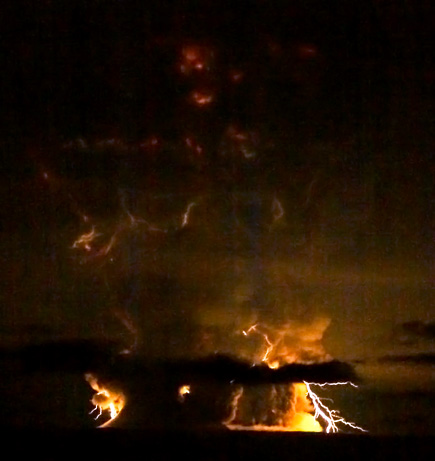
Lightning over Alaska’s Redoubt Volcano during the March 2009 eruption.
Otago Space Physics “Hits the Road”
This week the entire Space Physics group is travelling for work, but mostly not together! Prof. Craig Rodger left the University of Iowa (USA) where he is reseacrhing supported by a Fulbright New Zealand Scholar Award and travelled to Prague (Czech Republic) to represent New Zealand at the 26th IUGG General Assembly. Assoc. Prof. Neil Thomson is in Canada and Denmark to undertake a set of field campaign measurements. PhD student Aaron Hendry, who was working British Antarctic Survey (UK), finished his European holiday and arrived in Prague to join Craig at the IUGG conference. PhD student Kathy Cresswell-Moorcock left Dunedin for Boulder (USA) to take part in the NCAR Advanced Study Program Summer colloquium entitled Climate, space climate, and couplings between. And this week Dr. James Brundell and PhD student Emma Douma went to Christchurch (New Zealand) to attend the 2015 Antarctic Science Conference. It must feel very quiet in the Space Physics lab space [1 July 2015].
Craig Rodger’s Fulbright Scholar Award taken up in the USA
Prof. Craig Rodger was awarded a Fulbright New Zealand Scholar Award to spend time working and living in the USA. He left New Zealand last week (28 May), and is now in Iowa City. The Fulbright Scholar 5-month period is split between the University of Iowa in Iowa City and the University of Colorado in Boulder. Craig will spent about 6-months in the USA on sabbatical, so after the Fulbright period he will also travel to Hanover to visit Dartmouth College supported by a Matariki Network of Universities’ (MTU) Travel Award [5 June 2015].
Aaron working at the British Antarctic Survey (Cambridge, UK)
Space Physics PhD student Aaron Hendry left New Zealand on Friday 22 May 2015 to undertake a collaborative visit to the British Antarctic Survey. He is working with our long-term collaborator Dr. Mark Clilverd to better understand EMIC-driven electron precipitation into the atmosphere, combining satellite and ground based data. Both magnetometer and AARDDVARK data are being used. Aaron is supported by a Claude McCarthy Fellowship. He will also take a holiday while in Europe, and attend the 26th IUGG General Assembly in Prague [5 June 2015].
Emma re-joins us to undertake a PhD
Emma Douma will be pursuing a PhD in the Space physics group, attempting to understand strong diffusion. She has been awarded the prestigious Fanny Evans Postgraduate Scholarship for Women and started working towards her PhD on the 1st of March. Emma didn’t really leave the group, as she undertook her Honours project research with us in 2014, and was then a summer fellowship research student [25 March 2015].
Kathy wins University of Otago PhD Scholarship
Space Physics MSc student Kathy Cresswell-Moorcock has recently won a University of Otago Doctoral Scholarship to cover three years of study for her PhD. She is staying with the Otago Space Physics group for this study which started in December 2014. Kathy also graduated with her Masters of Science awarded with Distinction on 13 December 2014 [25 March 2015].
Craig Rodger wins Editors’ Citation for Excellence in Refereeing – Journal of Geophysical Research Space Physics
Prof. Craig Rodger heard today that he been recommended by the editors of Journal of Geophysical Research: Space Physics to receive the 2014 Editors’ Citation for Excellence in Refereeing. JGR – Space Physics is published by the American Geophysical Union. The citation reads “One of the most important services performed for AGU is the conscientious reviewing of submitted papers. Because of the nature of the reviewing process, this service is also one of the least recognized. The purpose of this citation is to express publicly the gratitude of AGU to those whose reviews have been particularly commendable.” A photo and formal annoucement is to be published in a future issue of AGU’s Eos Earth & Space Science News [13 March 2015].
Craig Rodger gives plenary lecture in Svalbard
On the last day of February Prof. Craig Rodger travelled to Norway to take part in the 5th Birkeland Centre for Space Science meeting at the University Centre in Svalbard (UNIS), Longyearbyen, Svalbard. Svalbard is a Norwegian archipelago in the Arctic Ocean located about 2000km north of Oslo. Craig gave the plenary lecture at the 5th BCSS workshop on Tuesday 3 March 2015 at UNIS which was carried on the twitter feed of the Birkeland Centre. Craig combined his visit to Norway with travels to the British Geological Survey in Edinburgh and Physics at Lancaster University [3 March 2015].
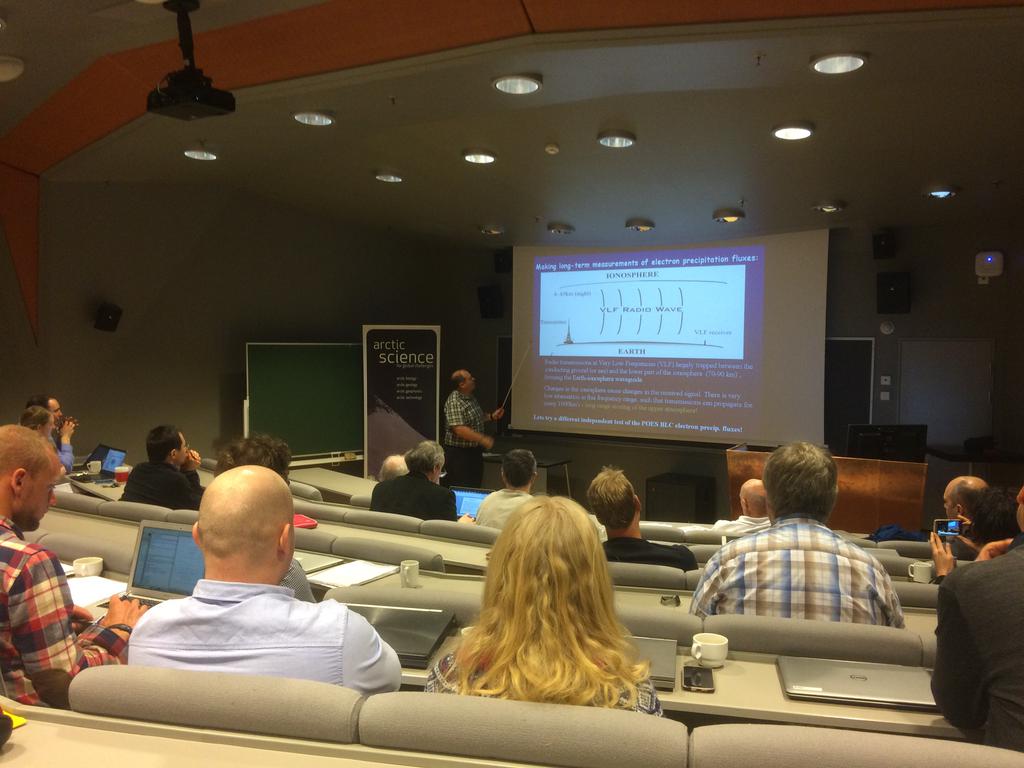
Craig giving his plenary lecture at the 5th BCSS meeting.
Mark Clilverd visiting for his yearly time in Dunedin
Each year Mark Clilverd from the British Antarctic Survey comes to visit the Otago Space Physics group – this very long-standing collaboration has produced a lot of science, and influenced a lot of student projects. In 2015 Mark came to us for two weeks in early-mid January – at the height of a truly wonderful Dunedin summer. We celebrated his birthday with penguin spotting at the Kaitiki Point Penguin colony and have enjoyed working on our laptops in Craig’s garden. Mark has also worked strongly alongside the groups 3 PhD students (Aaron, Kathy and Emma). Its been a highly productive visit with two papers finished off and another one started. We are sorry to see Mark leave, but he now heads away to Switzerland to attend a meeting at the International Space Science Institute. [23 January 2015].
For newer or older news, look at the drop down Space Physics News Listing!